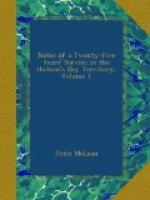[1] I would recommend this mode of conducting “affairs of honour” to honourable gentlemen using the hair-trigger, as an improvement. Though practised by savages, it must be allowed to be somewhat less barbarous than ten paces’ distance, and standing still! If the exhibition should appear somewhat ludicrous, both parties would have the additional “satisfaction” that their morning exercise had given a keener zest to their breakfast. It would be a sort of Pyrrhic dance.
Their chiefs have still considerable authority; but much of the homage they claimed and received in former times is now transferred to the white chiefs, or traders, whom they all esteem the greatest men in the universe. “After the Man of heaven,” said old Guaw to Mr. Dease, “you are next in dignity.” Owing to the superstitious notions of the people, the chiefs are still feared on account of the magical powers ascribed to them; it is firmly believed they can, at will, inflict diseases, cause misfortunes of every kind, and even death itself; and so strong is this impression, that they will not even pass in a direction where the shadow of a chief, or “man of medicine,” might fall on them, “lest,” say they, “he should bear us some ill-will and afflict us with some disease.”
These conjurors, nevertheless, are the greatest bunglers at their trade of any in the Indian territory; they practise none of the clever tricks of the Sauteux sorcerers, and are perfectly ignorant of the medicinal virtues of herbs and plants, with which the Sauteux and other Indians often perform astonishing cures. The Takellies administer no medicine to the sick; a variety of ridiculous gesticulations, together with singing, blowing, and beating on the patient, are the means they adopt to effect their end; and they, not seldom, effectually cure the patient of “all the ills of life.” Whether they effect a cure or not, they are sure to be well recompensed for their expenditure of wind, an article of which they are not sparing: they, in fact, exert themselves so much that the perspiration pours from every pore. The only real remedy they use, in common with other Indians, is the vapour-bath, or sweating-house. The house, as it is termed, which is constructed by bending twigs of willow, and fixing both ends in the ground, when finished, presents the appearance of a bee-hive, and is carefully covered to prevent the escape of the vapour; red-hot stones are then placed inside, and water poured upon them, and the patient remains in the midst of the steam thus generated as long as he can bear it, then rushing out, plunges into the cold stream. This is said to be a sovereign remedy for rheumatism, and the natives have recourse to it in all cases of severe pain: I myself witnessed its efficacy in a case of paralysis.




